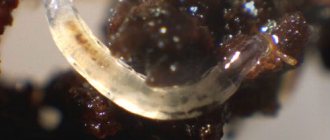Cystitis in dogs can occur at any age—even puppies are susceptible to the disease. The risk group includes older dogs, short stature dogs, and miniature breeds. Veterinarians note certain symptoms of cystitis in dogs, which will help owners identify this particular disease.
If your dog's symptoms indicate cystitis, then urgent treatment is required. Cystitis is observed more often in bitches, which is due to the anatomy of the female urinary system. The disease is affected by estrus, pregnancy, and childbirth, since hormonal changes contribute to a decrease in immunity, which affects the proliferation of pathogenic microorganisms. Cystitis can also develop as a result of unprofessional surgical intervention: failure to comply with sterility rules causes inflammation in dogs. Inflammatory processes in the bladder are leading among other diseases of the genitourinary system in dogs. The most common cause contributing to the development of cystitis is hypothermia. In second place is the pet’s weak immunity. Treating cystitis in dogs is not difficult if you notice changes in time. But advanced forms of the disease are very dangerous for the health of dogs. So how does cystitis manifest in dogs? And what are the causes of cystitis in dogs?
Causes of cystitis in dogs
Bladder inflammation in dogs can be caused by various causes. The most common reasons are:
- hypothermia of the animal;
- diseases of the genitourinary system;
- infections.
Representatives of different breeds tolerate cold differently. Large breed dogs have good immunity, so they can easily endure walks in cold weather. For dogs of decorative breeds, a half-hour walk in the rain will be enough to get sick.
This is important to know! At home, a pet becomes hypothermic if it sleeps on a cold floor. The problem arises if the dog is constantly in an uninsulated enclosure.
Cystitis appears as a complication of other diseases, for example, it is provoked by urolithiasis. Urine stagnates in the bladder, and stones damage the sensitive mucous membrane.
The most common cause of cystitis is infection. Bacteria appear in a dog's bladder in different ways: from the kidneys, through the blood, or through the urethra. If infection occurs against the background of other diseases, then we can talk about bacterial cystitis.
Cystitis develops more often in girls than in males. This phenomenon can be explained by the structural features of the urethra, which is located close to the anus. Girls are worried about cystitis during pregnancy if the period of gestation of puppies is accompanied by complications.
Chronic cystitis: new in diagnosis and treatment
If the diagnosis of chronic bacterial cystitis in most cases does not cause difficulties, then treatment is not always effective, and the prognosis is not always favorable, since in some cases it is not possible to identify and then eliminate the cause of the disease. Treatment of chronic cystitis requires a doctor to have a broad outlook, knowledge of the problems of gynecology, neurology, and immunology. During the development of the disease, structural changes are ahead of clinical manifestations, and, conversely, during the recovery process, normalization of impaired functions occurs before the restoration of damaged structures, i.e., morphological manifestations are delayed compared to clinical ones [16]. Only mature epithelial cells are resistant to bacteria, while the barrier function of the epithelium in the presence of epithelial cells with a moderately differentiated ultrastructure is impaired. For the treatment and prevention of chronic recurrent lower urinary tract infections, etiotropic antibacterial therapy is used in 7–10-day courses. Research by Vozianova A.F., Romanenko A.M. et al. (1994) showed that complete restoration of mature surface epithelial cells of the bladder after their damage lasts at least 3 weeks [26]. Thus, in the absence of vigilance on the part of the attending physician and lack of due attention to the duration of pathogenetic treatment, another relapse may be layered on the reparative phase of the previous process. This in turn leads to increased collagen formation, discorrelation and sclerosis of subepithelial structures, which play a major role in the homeostasis of the bladder mucosa and its innervation [27]. Thus, a vicious circle arises: inadequate treatment - chronic inflammation - reactive changes and scarring of submucosal structures - tissue hypoxia - incomplete regeneration of the epithelium - another exacerbation of the process.
Treatment of chronic recurrent cystitis:
- Etiological: antibacterial therapy.
- Pathogenetic - correction of anatomical disorders, correction of immune disorders, improvement of microcirculation, treatment of STIs, correction of hormonal disorders, treatment of inflammatory and dysbiotic gynecological diseases, correction of hygienic and sexual factors, local treatment.
- Preventive - herbal diuretics, antibacterial therapy (including postcoital prophylaxis).
Etiological treatment is antibacterial therapy based on the following principles: duration (up to 7–10 days); choice of drug taking into account the isolated pathogen and antibiogram; prescribing antibiotics with bactericidal action. The drugs to which the largest percentage of sensitive strains of urinary infection pathogens have been isolated in Russia are: fosfomycin - 98.6%, mecillinam - 95.4%; nitrofurantoin - 94.8% and ciprofloxacin - 92.3% [28]. The most preferred are norfloxacin, ciprofloxacin, pefloxacin and levofloxacin due to the absence of unwanted adverse reactions.
The choice of antibacterial drug should be made on the basis of microbiological research data. If for acute uncomplicated cystitis, preference should be given to short courses of antibacterial therapy (3–5 days), then for chronic recurrent cystitis, the duration of antibacterial therapy should be at least 7–10 days for complete eradication of the pathogen, which in chronic cystitis can be localized in submucosal structures bladder walls [1, 5].
Antibacterial therapy. The drugs of choice are fluoroquinolones (ciprofloxacin, ofloxacin, norfloxacin, levofloxacin, lomefloxacin), which have very high activity against E. coli and other gram-negative pathogens of uroinfections. Non-fluorinated quinolones - nalidixic, pipemidic, oxolinic acids have lost their leading importance due to the high resistance of microflora to them, and cannot be the drugs of choice for recurrent urinary tract infections [18, 29].
The choice of fluoroquinolones is due to a wide spectrum of antibacterial activity, pharmacokinetics and pharmacodynamics, and the creation of high concentrations in the blood, urine and tissues. The bioavailability of fluoroquinolones does not depend on food intake; they have a long half-life, which allows taking the drugs 1–2 times a day. They are distinguished by good tolerability and the possibility of use in renal failure. For norfloxacin, the half-life is 3–4 hours; for the treatment of exacerbation of cystitis, it is recommended to take 400 mg 2 times a day for 7–10 days. Ciprofloxacin is considered the most powerful antibiotic from the group of fluoroquinolones, since, providing a bactericidal effect in small concentrations, it has a wide spectrum of antibacterial activity and is quickly distributed and accumulates in tissues and biological fluids with high intracellular concentrations in phagocytes (take 500 mg 2 times a day). Currently, drugs have been created that provide ease of administration - once a day. An example would be Ificipro® OD, which is a new sustained-release formulation of ciprofloxacin.
When an STI is detected, a course of antibacterial therapy is required with the inclusion of macrolides, tetracyclines, fluoroquinolones, aimed at eradicating the pathogen, followed by monitoring of the microflora.
Pathogenetic treatment begins with recommendations for maintaining a work-rest regime and prescribing appropriate nutrition. Drink plenty of fluids. Increased diuresis helps flush out bacteria and other pathological impurities. Dysuric phenomena are reduced due to the action of concentrated urine on the mucous membrane of the bladder. Food should be complete in protein and vitamin content and promote intestinal motility. Currently, pathogenetically based algorithms for conservative treatment of inflammatory diseases of the lower urinary tract have been developed [18].
The availability of modern antibiotics and chemotherapy drugs makes it possible to quickly and effectively treat recurrent urinary tract infections and prevent their occurrence. The unreasonableness and irrationality of antibacterial therapy are factors leading to chronicity of the process and disturbances of immunoregulatory mechanisms with the development of immunodeficiency states. It is important that the immunodeficiency state may not have clinical manifestations [30]. The concept of “immunodeficiency” includes conditions in which there is an absence or decrease in the level of one or more immune factors. Studies conducted in our clinic have shown that patients with chronic cystitis have deviations in the immune status in the form of an increase or decrease in indicators from the average norm in 33.3%. An alternative to prescribing antibacterial drugs is to stimulate the patient’s immune mechanisms when prescribing immunotherapeutic drugs. One such preparation is a lyophilized protein extract obtained by fractionating an alkaline hydrolyzate of certain strains of E. coli. The drug is available in capsules and has the trade name Uro-Vaxom. Stimulation of nonspecific immune defense mechanisms by Uro-Vaxom is an acceptable alternative to low-dose long-term chemoprophylaxis of urinary tract infections [31].
The use of polyvalent bacteriophages in the treatment of chronic recurrent cystitis is noteworthy, which is especially important for patients with a polyvalent allergy to antibacterial drugs or the presence of multidrug-resistant pathogens. Despite the lack of placebo-controlled studies of the use of pyobacteriophages, the clinical effectiveness of these drugs is beyond doubt [18].
The most important element in the pathogenetic therapy of cystitis, which can prevent chronic inflammation, is immunomodulatory therapy. Regulators of immune reactions are cytokines, their main component being interferons (INFs). The functions of INF in the body are varied, but the most important function of INF is antiviral. In addition, INF are also involved in antimicrobial protection and have antiproliferative and immunomodulatory properties. INF are capable of modulating the activity of other cells, such as normal killer cells, increasing the lysis of target cells, the production of immunoglobulins, the phagocytic activity of macrophages and their cooperative interaction with T and B lymphocytes. Gamma-INF inhibits the growth of tumor cells and suppresses the intracellular proliferation of bacteria and protozoa [9, 30]. There are drugs containing exogenous INF. However, INF inducers have advantages over them because they are devoid of antigenic properties, their synthesis in the body is always strictly balanced and, thus, the body is protected from oversaturation with interferons [32]. For the first time, for the complex treatment of chronic recurrent cystitis, we used tilorone, the trade name of the drug “Lavomax®” (125 mg tablets). Taking the drug "Lavomax®" made it possible to achieve remission of the disease in 90%, eradication of microflora in the urine was achieved in 66.7%. The results of our studies showed the undoubted promise of using Lavomax® not only for the treatment, but also for the prevention of chronic cystitis.
The chronic process, taking into account the concomitant pathology of the patients, requires the mandatory use of drugs to combat tissue hypoxia - antihypoxants (Solcoseryl 200 mg, 1 tablet 2 times a day, course 14 days); venotonics (Eskuzan 20); antiplatelet agents that improve the “fluidity” of blood through the capillaries. A typical representative of the group of antiplatelet agents is Trental, which has a vasodilator, antiplatelet, angioprotective effect (100 mg 2-3 times a day, for a course of up to 30 days), the active substance is pentoxifylline. Pentoxifylline-Acri is easy to take, as it comes in a tablet form of 100 mg, improves microcirculation and oxygen supply to tissues, mainly in the limbs, central nervous system, and to a lesser extent in the kidneys. There are a lot of drugs that improve arterial and venous circulation. However, today there is a drug that can restore microcirculation and muscle tone of the bladder; its beneficial effect on immunity indicators has been proven. This is Prostatilen, which has proven itself in the treatment of prostate diseases - a complex of polypeptides isolated from the tissues of the prostate gland of cattle [33]. We were interested in the ability of peptides (cytomedines) to act as bioregulators in the body. Their action is presumably carried out through receptors located on the surface of cells. As a result of their introduction into the body, endogenous regulatory peptides are released and the effect of cytomedins is prolonged [34]. The drug “Vitaprost®” (50 mg rectal suppositories), traditionally used in the treatment of pathologies of the male genital area, was first used in the Nizhny Novgorod urology clinic for the treatment of chronic recurrent cystitis in women. By studying capillary blood flow in the bladder mucosa in patients with chronic recurrent cystitis using laser Doppler flowmetry (LDF) [35, 36], we obtained an objectively proven effect from the use of this drug (Fig. 3). In Fig. 3 and monitoring before treatment, microcirculation index (PM) - 4.7 perfusion units. In Fig. 3 b monitoring after treatment (PM - 18.25 perfusion units).
Before treatment, patients had a stagnant type of blood flow with reduced activity of microcirculatory components and tissue ischemia. The biostimulating drug “Vitaprost®”, used as pathogenetic therapy in the treatment of chronic cystitis, contributed to the rapid disappearance of the inflammatory process and stimulation of regenerative processes, which we monitored with CP OCT. The prescribed drug made it possible to achieve a rapid effect of analgesia and helped achieve social adaptation of the patients in a fairly short time.
Treatment of recurrent lower urinary tract infections occurring against the background of STIs, in the presence of dysplastic processes in the posterior urethra, bladder neck area, and bladder triangle should be aimed at eradicating atypical pathogens and restoring the mucin layer of the urothelium. The formation of a mucopolysaccharide layer, which normally covers the epithelium of the bladder, is considered a hormonal-dependent process: estrogens affect its synthesis, progesterone affects its secretion by epithelial cells. The use of female sex hormones intravaginally leads to proliferation of the vaginal epithelium, improved blood supply, restoration of extravasation and elasticity of the vaginal wall, increased glycogen synthesis, restoration of the population of lactobacilli in the vagina, and acidic pH. An example of estrogen for the treatment of urogenital disorders is the drug estriol - Ovestin, available in tablet form 2 mg and in the form of vaginal suppositories of 0.5 mg. When using any form, Ovestin is prescribed once a day.
In the presence of severe pain, nonsteroidal anti-inflammatory drugs are prescribed that suppress the synthesis of prostaglandins and have a pronounced analgesic effect. Indomethacin, diclofenac and others are prescribed. The drugs are used in usual doses for 10–21 days, maintaining dosages for up to 2 months. The effect of nonsteroidal anti-inflammatory drugs usually lasts for 3–4 months after their discontinuation [1].
The prescription of antihistamines and antiserotonin drugs is necessary to eliminate etiological and pathogenetic factors. This could be the drug "Peritol" - an H1-histamine receptor blocker with a pronounced antiserotonin effect. It also stabilizes mast cells and prevents their degranulation with the release of biologically active substances. Its anticholinesterase activity affects the storage function of the bladder. The drug is taken with 2 mg - 1 time per day, gradually increasing the dose to 4 mg - 3 times a day for 3-4 weeks. Zaditen (ketotifen) is prescribed in a dose of 0.5–1 mg, 2 times a day for 2–3 months. Other antihistamines (Diazolin, Tavegil, Claritin) are also prescribed as usual for 1–3 months.
Main symptoms of cystitis
Pet owners may not always detect the first symptoms of the disease. The inflammatory process develops rapidly, so the dog’s condition quickly deteriorates. Symptoms of cystitis include:
- frequent urination;
- the occurrence of false urges;
- the dog begins to whine when urinating;
- clots of pus or blood appear in the urine;
- painful sensations in the abdomen;
- loss of appetite, loss of strength;
- specific smell of urine;
- increase in body temperature.
In a male dog, you can easily identify signs of cystitis by observing the process of urination. If the dog is bothered by painful sensations, he will not be able to lift his paw and will squat when urinating.
Cystitis in puppies
Cystitis in puppies has a different origin than in adult dogs. The source of the disease is most often not infection or decreased immunity. Cystitis begins in a puppy due to improper feeding, namely a lack of drinking water. Water deficiency affects urinary stagnation, irritating the urethra. Since puppy urine is concentrated, it quickly crystallizes, settling on the walls of the bladder and causing inflammation. Irritated mucous membranes cause narrowing of the urethra, which favors the proliferation of pathogenic bacteria. It is extremely important for the owner to notice the symptoms of cystitis in a puppy in time in order to prevent the development of a serious process.
The manifestations of cystitis in a puppy and an adult dog are similar. This is frequent urination, a small amount of urine, in acute cases mixed with blood and mucus. The puppy whines when urinating, which indicates a painful process. There may be irritation, swelling or rashes in the pet's genital area, which causes him anxiety: he often licks this area. If a puppy has symptoms of cystitis, then treatment is required.
Ignoring such symptoms by the owner often leads to a chronic form of the disease. It is fraught with complications of diseases of the genital organs, as well as infertility and the inability to bear healthy offspring. Due to physiological characteristics, cystitis is more common in female puppies.
How to distinguish between cystitis and estrus?
During estrus, it can be difficult to determine cystitis, since its symptoms coincide with the signs of menstruation. It is easier to diagnose a disease in a dog if you pay attention to the presence or absence of important features. The following characteristic features will help identify bladder inflammation:
- pain when urinating (estrus is painless);
- specific and unpleasant odor of urine;
- the appearance of a false urge to urinate.
With cystitis and estrus, the following symptoms may appear: increased body temperature, loss of strength, loss of appetite, blood clots in urine.
Sterilized dogs may experience complications such as frequent urination. The pet owner should not ignore this. Complications go away on their own, but sometimes require treatment. Cystitis is often confused with complications after castration of a dog. Animals that have been spayed or neutered require diagnostics. An experienced doctor can identify signs of bladder problems.
Pathways to bladder infection
Cystitis is always caused by infection of the organ. There are two routes of infection:
- ascending - the infection penetrates from below or from the outside, for example, from the anus;
- descending - the infection “descends” into the bladder from other organs.
Downward transmission occurs through urine if the kidneys are infected, or through lymph or blood flow if other organs are affected by pathogenic microorganisms. In most cases, infection occurs along the ascending route, that is, inflammation occurs due to the penetration of microorganisms into the urethra from the anus.
Due to the structural features of the genital organs, cystitis is more common in females than in males.
What are the types of cystitis?
The disease is classified according to its duration. Veterinarians talk about two types of cystitis:
- spicy;
- chronic.
Acute cystitis immediately manifests itself with the first symptoms, in which the dog feels discomfort. The pain when urinating rapidly increases. If there is no treatment, purulent cystitis appears. This form of the disease provokes dangerous complications.
Chronic cystitis is permanent. The animal needs therapy, which is prescribed for life. An exacerbation occurs after the dog is hypothermic, so the pet will need special care. Treatment of the chronic form of the disease will be simple, because it consists of preventing exacerbation.
Cystitis in dogs is classified according to the reasons for its occurrence. There are 2 types of cystitis:
- primary;
- secondary.
Primary or idiopathic cystitis can be an independent disease. This pathology appears due to the fact that the infection enters directly into the bladder.
Secondary cystitis often occurs against the background of other pathological conditions. This may be an infection that enters the genitourinary system or other internal organs.
Dogs have acute hemorrhagic cystitis. The disease is accompanied by profuse bleeding. This happens as a result of injury to the bladder wall. Another form of pathology is allergic cystitis. The main causes of allergic cystitis are complications after asthma, the presence of allergies in the animal, problems with the respiratory system.
Types of disease
Classification by type of disease depends not only on the route of infection (ascending, descending) and the order of occurrence of the inflammatory process (primary, secondary). Depending on the cause and symptoms that appear, cystitis is divided into the following types:
- Purulent
. Accompanied by fever and acute intoxication by bacterial waste products. Along with urine, purulent clots and blood streaks come out.
- Phlegmonous
. Occurs in immunodeficiency and paracystitis (inflammation of the fiber of the ureter). It is detected during diagnosis by an excessive number of leukocytes.
- Idiopathic
. There are no obvious reasons for the violations. The disease is associated with increased levels of stress, which increases vascular permeability.
- Ulcerative
. A more dangerous variant of the purulent form, deeply affecting the muscle tissue.
- Gangrenous
. Severe inflammation, causing partial or complete tissue death.
- Serous-catarrhal
. It is characterized by severe swelling of the mucous membranes, dilation of blood vessels and detachment of the bladder epithelium. Cloudy urine contains impurities of mucus and dead leukocytes.
- Hemorrhagic
. Diagnosed together with purulent or serous-catarrhal forms. Leads to increased permeability of blood vessels and profuse hemorrhages. The urethra becomes clogged not with stones, but with blood clots.
Depending on the duration of cystitis in a dog, it can be chronic or acute. In the first case, exacerbations alternate with remissions, so the main goal of treatment is to prevent new relapses. The acute form is accompanied by poorer health and acute symptoms, but can be completely cured.
What is the danger of the disease?
Cystitis provokes the development of various complications. A great danger to a dog’s body is pyelonephritis or kidney disease. Pyelonephritis is accompanied by purulent formations and a complex inflammatory process. The pet experiences not only discomfort, but also pain. In case of bilateral form of pyelonephritis, death cannot be ruled out.
If a dog develops cystitis as a result of infection, then the danger increases even more, because the pathogenic microflora spreads to neighboring organs. The animal's genitals and kidneys may be damaged. In this case, you will have to treat not one, but several diseases.
Possible complications
If your pet has an inflamed bladder, it is necessary to show it to a veterinarian as soon as possible. With late treatment, the acute form develops into a chronic form, which increases vulnerability to low temperatures.
If an infection occurs, there is a possibility of bacterial infection of the blood and kidneys. This compromises the reproductive system, causing kidney failure and peritonitis. With this outcome, treatment is delayed indefinitely. Particularly dangerous is the disease with a bilateral form of pyelonephritis, often leading to death.
Diagnostic measures
A special characteristic of cystitis is that it manifests itself pronouncedly. At the first symptoms of the disease, you must take your pet to a veterinary clinic. Diagnosis of cystitis is that the veterinarian confirms the inflammatory process in the bladder. A treatment regimen is developed after diagnostic measures have been completed. Diagnostics include:
• general and additional urine tests; • Ultrasound of the kidneys; • smear for genital bacteria.
It is important! The symptoms of cystitis should not be confused with signs of urolithiasis. To prevent this, ultrasound must be included in the diagnosis of cystitis. Signs of the presence of kidney stones in the dog are visible in the picture. If there are no kidney stones, then we can talk about inflammation of the bladder.
How is diagnostics carried out?
Before starting treatment for cystitis in dogs, it is necessary to conduct a thorough diagnosis. This is done to ensure that the diagnosis is correct, because some pathologies of the genitourinary system have similar symptoms.
For a veterinarian, signs such as frequent urination in small portions and the presence of blood in the urine already confirm the diagnosis, but the doctor prescribes additional studies to clarify it:
- The bladder is palpated to determine its fullness. Fullness of the urinary tract and difficulty in excreting urine are characteristic symptoms of cystitis.
- A bacteriological analysis of urine is carried out to identify the presence of pathogenic microorganisms in it and determine their sensitivity to antibiotics.
- The urine is examined under a microscope to look for pus, blood and sand. Such impurities indicate stagnation and development of the inflammatory process in the bladder and that the dog has urolithiasis.
- A swab is taken from the dog's genitals to check for infectious diseases.
The diagnosis is confirmed if the study shows the presence of pathogenic microorganisms and sediments of inorganic substances in the urine.
Further diagnosis is carried out only after urine is removed by catheterization. In the emptied bladder, the doctor can use palpation to detect stones that have blocked the urinary canal and caused cystitis.
Using X-rays and ultrasound of the dog's pelvic organs, the size of the stones and the degree of inflammation in the bladder are assessed, and the presence of tumors in it is determined.
Cystitis in dogs is curable, so after diagnosis, the animal owner will need to strictly adhere to the doctors’ recommendations so that treatment takes a minimum of time.
How is cystitis treated at home?
In cases where the pet's condition does not pose a threat to its life, treatment can take place at home. The animal will need hospitalization if complications develop. Under the supervision of a specialist, IVs are placed and other procedures necessary for treatment are performed.
Treatment of cystitis at home has its own rules and characteristics. The first step is to provide the dog with proper living conditions. The dog is taken into the house if the pet lives on the street. Insulate the sleeping area and add several bedding. Drafts must be eliminated in the room. In such conditions, treatment of cystitis will be most effective.
Recovery lasts from 10 to 14 days, but in advanced conditions it will take longer. Treatment of cystitis will not be quick, because it is necessary to eliminate the inflammatory process.
How to care for an animal
When treating at home, it is important to pay attention not only to nutrition, but also to the maintenance of the patient. Build your pet a comfortable sleeping place in a room protected from drafts. Avoid lying on concrete floors.
Remember that using a heating pad on a diseased organ is strictly prohibited! Heat exposure promotes more active growth of bacteria and aggravates the inflammatory process.
Heating devices are no less dangerous. To keep your dog warm, it is enough to take care of a warm bedding and blanket.
If the pet lives in a kennel or enclosure, then it will have to be given a place inside the house until it recovers. Otherwise, taking the drugs will not bring the desired effect, and the disease will become chronic.
Medicinal treatments
Drug treatment of cystitis in dogs is based on the use of antibiotics. The action of antibiotics is complemented by antispasmodics, which alleviate the animal’s condition and eliminate pain. Veterinarians may prescribe different medications:
- furadonin;
- biseptol;
- furagin;
- canephron;
- cystone;
- dexamethasone.
The dosage of furadonin is selected taking into account the weight of the dog; for example, a quarter of a tablet will be enough for small decorative breeds. If the dog weighs 60 kg, you need to use 4 tablets per day. Furadonin is given to the pet with food.
Biseptol helps eliminate gram-positive and gram-negative bacteria and is considered a universal remedy. Biseptol tablet is designed for a dog weighing 50 kg. For representatives of small breeds, the dosage is calculated individually.
Furagin injections are considered especially effective. The course of injections is 1 week. The use of the drug provides anti-inflammatory and antibacterial effects.
Canephron is suitable for oral use. Dogs are prescribed a few drops of canephron per 1 kg of weight. The course of treatment is 2 weeks.
After meals, you can give your pet plant-based tablets. The dog is given 2 tablets at least 2 times a day. Cyston is suitable for long-term use (from one to three months) and is considered a prophylactic agent.
Dexamethasone will be effective for allergic cystitis. The hormonal product contains disodium phosphate. Use the product once 1-2 times a day. Dexamethasone has an anti-inflammatory, antiallergic effect.
Nolitsin is a universal drug for cystitis. The duration of use of the drug should not exceed 7 days.
Treatment at home
A dog can be treated at home only after examination by a veterinarian, who will definitely prescribe general urine and blood tests. In some cases, an ultrasound examination is required to determine the presence of stones, sand, the extent of inflammation, cystoscopy to examine the inside of the bladder and therapeutic lavage. Based on the examination results, the specialist will make a diagnosis, determine the nature of the inflammation, prescribe medications and select the appropriate dosage.
ADVICE! Treatment should not be started without consulting a veterinarian. It is necessary to identify the cause of inflammation and treat cystitis comprehensively. If you only remove the symptoms, the inflammation will become chronic and will regularly remind itself of itself with relapses.
Medicines
The doctor allows treatment of cystitis in dogs at home only after diagnosis and if the disease has not reached a critical stage. Otherwise, hospitalization of the animal is necessary.
Therapy is carried out comprehensively with drugs from several groups:
1) Antibiotics - drugs in this group are necessarily prescribed for cystitis. They help eliminate inflammation. It is preferable to choose not tablets, but a solution for intramuscular administration. This way antibiotics act much faster, stronger and without side effects. The most effective antibiotics are Tsiprolet, Monural, Baytril, Tsnftriaxon, Furadonin.
2) Immunomodulators - these medications restore reduced immunity. Ribotan, Gamavit, Immunofan are often prescribed.
3) Antispasmodics - drugs are necessary to relieve pain during urination. Thanks to antispasmodics, swelling of the urethra decreases, urine comes out freely. Veterinarians prescribe Cyston, No-shpu.
4) Antimicrobial drugs Antimicrobial drugs for the treatment of cystitis are prescribed to an animal if the disease is of an infectious nature. They kill pathogenic microorganisms found in the urinary tract. Most often prescribed are Norbactin, Furagin, Nitroxoline.
5) Antihistamines - the veterinarian prescribes antiallergic medications if cystitis has developed as a result of an allergic reaction. Suprastin and Allervert are considered popular.
6) Diuretics - diuretics are necessary to ensure that urine is excreted on time and in normal quantities. This way it will not stagnate and cause inflammation and intoxication. Canephron is considered the most effective drug.
ethnoscience
Along with drug therapy, the treatment of cystitis in dogs can be supplemented with folk remedies (if the veterinarian allows it). Together, they allow you to quickly cope with the disease. Decoctions of oregano, lingonberry, and bearberry help. They have a mild diuretic effect. Strong diuretics should not be given to a dog for cystitis. Infusions of parsley and St. John's wort help reduce inflammation. Decoctions of mint and lemon balm relieve spasms and pain when urinating. Auxiliary treatment with folk remedies should not last more than 10 days.
Pet diet for cystitis
Treatment of cystitis in dogs must include the right menu. Diet also affects the healing process. When choosing a daily diet, you must adhere to certain rules:
- Do not give your dog fatty, spicy, salty foods;
- smoked meats and sausages are excluded from the diet;
- you should avoid adding salt;
- you need to give preference to high-quality feed;
- the menu should include vegetables;
- For some breeds, fermented milk products and cottage cheese are suitable;
- Additionally, you can introduce vitamin complexes;
- Access to drinking water must be ensured.
Your pet needs to be fed dietary foods because antibiotics are used to treat it. These medications negatively affect the functioning of the digestive system. A proper diet is a guarantee of successful treatment of cystitis.
Feeding and drinking regimen
For recovery, not only medications are important, but also proper nutrition. During treatment, the animal is prescribed a gentle diet that reduces the load on the affected organs.
When dry feeding, it is recommended to switch to a line of veterinary foods designed for pets with pathologies of the urinary system. They can be found at Hill's, Pro Plan, Royal Canin, Advance or Farmina. The packaging of medicated food must be marked C/D or S/D.
Dogs eating natural products are temporarily excluded from meat, fish and offal. An increased protein content has a detrimental effect on the kidneys, so it is replenished with natural fermented milk products (kefir, yogurt, fermented baked milk). They normalize the intestinal microflora, which is very important when taking antibiotics. The cereal used is oatmeal, which envelops and protects the walls of the stomach. All vegetables are taken boiled.
To reduce the amount of toxins and lower the concentration of urine, it is necessary to ensure adequate fluid intake. Before serving, it is filtered or boiled. In addition to water, it is recommended to give cranberry, currant or rose hip juice, which increases immunity.
Preventive actions
Prevention allows you to eliminate dangerous complications of cystitis in a dog. Simple actions are aimed at maintaining the health of your pet. Prevention includes the following precautions:
- When caring for your dog, use the principles of proper nutrition;
- give your pet only clean water;
- the dog should not drink water from unknown sources or from puddles;
- provide your pet with a warm and comfortable place to sleep;
- take your dog for a walk in any weather 2-3 times a day;
- Only proven animals are suitable for mating.
A routine examination will help avoid problems with your dog’s health. It is necessary to make an appointment for your pet to see an experienced veterinarian. The doctor will conduct a diagnosis and, if necessary, prescribe a treatment regimen.
Cystitis in dogs is one of the common diseases. The pathology occurs in representatives of different breeds. The disease can be quickly dealt with when the first symptoms are detected. The main cause of cystitis is considered to be infection, but the disease occurs due to hypothermia and other pathologies. Antibiotics are used to properly treat cystitis. Complex therapy is complemented by medications from other groups. When treating the disease, it is necessary to monitor the pet’s diet.
Medications
Medicines for the treatment of cystitis in dogs should only be prescribed by a veterinarian. If a bacterial infection is confirmed in a dog, the veterinarian will prescribe a course of antibiotics. They are designed to fight the infection that causes inflammation of the bladder and canals. The course ends with treatment of dysbiosis using probiotics and enterosorbents.
Antispasmodics help relieve spasms and reduce the intensity of spasms in your pet.
In case of blood loss, hemostatic drugs are used.
Good results in therapy are shown by diuretic, anti-inflammatory and antibacterial drugs on a natural basis.
In severe conditions and droppers are indicated, solutions necessary for catheterization are used.
Various drugs are used to combat the underlying cause of cystitis.
The dosage of each medicine is calculated by the doctor based on data about the disease, condition, weight, and age of the pet. The owner must strictly follow the veterinarian’s recommendations regarding the order and time of taking prescribed medications and injections.
Prevention
The disease is much easier to prevent than to treat. The dog should not have any contact with sick animals. The breeder needs to monitor which individual the pet mates with. Stray dogs should not be allowed near your pet during a walk. The animal for mating must be vaccinated and have a medical certificate confirming the absence of diseases.
The dog must have healthy gums and teeth. Animals clean their genitals with their tongues. Any inflammation in the oral cavity can affect the occurrence of cystitis. Long-haired pets need to trim the hair around the anus and near the genitals. It is advisable that the dog drinks clean water. During a walk, the owner should not allow the pet to lap from the puddle. The dog should not sleep under a fan or on a tiled floor, even in summer.
Every owner needs to know how to treat cystitis in dogs. The success of therapy is influenced not only by the drugs chosen by the veterinarian, but also by other procedures - the owner should provide his pet with complete rest and proper nutrition. Salty, spicy and fatty foods should be excluded from the diet. It is better to refuse food during treatment and switch to natural products.











